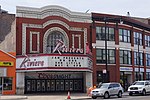Ravenswood, Chicago

Ravenswood is a neighborhood located on the North Side of the city of Chicago, Illinois. Lacking designation as one of Chicago's 77 well-defined community areas, it is mostly situated in the Lincoln Square community area, with the portion east of Ravenswood Avenue and the Chicago & Northwestern/Union Pacific North Line railroad tracks being situated in the Uptown community area. Ravenswood was founded in 1868 as an exclusive commuter suburb by a group of real-estate speculators. These speculators formed the Ravenswood Land Company and purchased 194 acres of farmland and woods eight miles north of Chicago. The woods supported a population of ravens. Ravenswood is known for its courtyard-style residential buildings. Once considered an "up and coming" neighborhood, Ravenswood has seen its real estate values skyrocket since the 1990s.
Excerpt from the Wikipedia article Ravenswood, Chicago (License: CC BY-SA 3.0, Authors, Images).Ravenswood, Chicago
North Clark Street, Chicago Uptown
Geographical coordinates (GPS) Address Nearby Places Show on map
Geographical coordinates (GPS)
| Latitude | Longitude |
|---|---|
| N 41.965555555556 ° | E -87.666666666667 ° |
Address
North Clark Street 4605-4607
60640 Chicago, Uptown
Illinois, United States
Open on Google Maps









